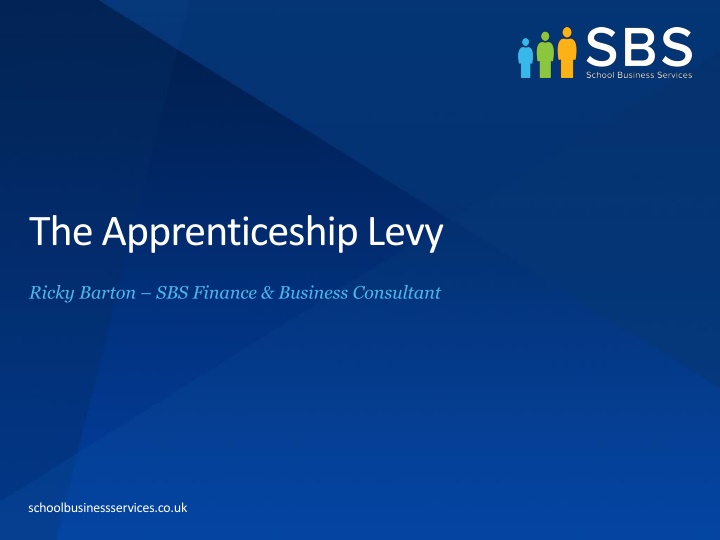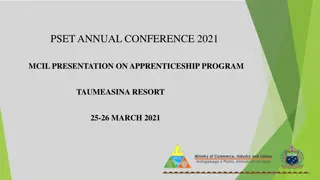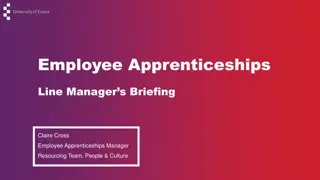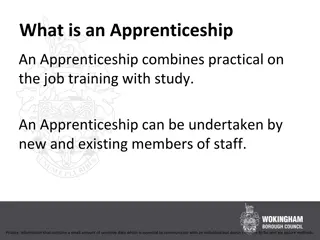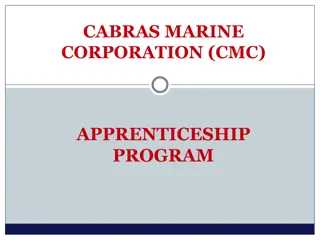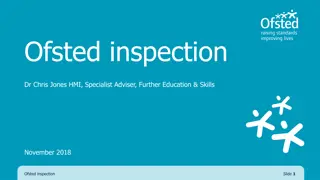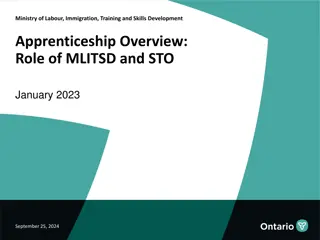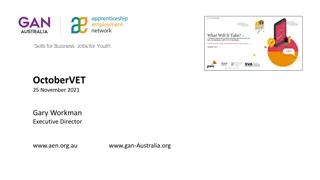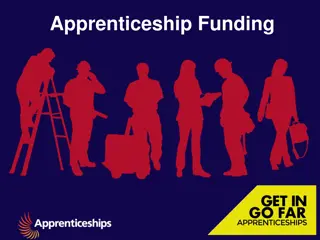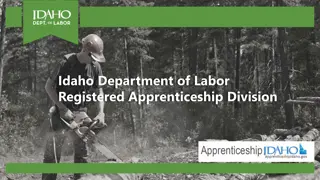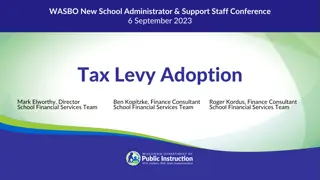The Apprenticeship Levy for UK Employers
The Apprenticeship Levy is a mandatory contribution from UK employers to fund new apprenticeships. Employers with a pay bill over £3 million annually will pay 0.5%, with an allowance of £15,000 to offset the levy liability. Employers can benefit from a 10% top-up to their digital accounts for apprenticeship training. Learn about paying the levy, calculating payments, and getting more out than you put in.
Download Presentation

Please find below an Image/Link to download the presentation.
The content on the website is provided AS IS for your information and personal use only. It may not be sold, licensed, or shared on other websites without obtaining consent from the author.If you encounter any issues during the download, it is possible that the publisher has removed the file from their server.
You are allowed to download the files provided on this website for personal or commercial use, subject to the condition that they are used lawfully. All files are the property of their respective owners.
The content on the website is provided AS IS for your information and personal use only. It may not be sold, licensed, or shared on other websites without obtaining consent from the author.
E N D
Presentation Transcript
The Apprenticeship Levy Ricky Barton SBS Finance & Business Consultant schoolbusinessservices.co.uk
What is the levy? The Apprenticeship Levy will be a levy on UK employers to fund new apprenticeships The levy will be 0.5% of the pay bill, paid through PAYE An allowance of 15,000 to offset against levy liability The levy allowance is not a cash payment and cannot be used to purchase apprenticeship training The levy will be set at 0.5% of an employers pay bill. It will only be paid on any pay bill in excess of 3m Employers will have an allowance of 15,000 to offset against their levy payment Any UK employer, in any sector, with a pay bill of more than 3 million per year is liable to pay the levy Employers in England who pay the levy and are committed to apprenticeship training will be able to get out more than they pay into the levy, through a top-up to their digital accounts schoolbusinessservices.co.uk
Paying the levy Levy Paying employer Employer of 250 employees, each with a gross salary of 20,000. Pay bill: 250 x 20,000 = 5,000,000 Levy sum: 0.5% x 5,000,000 = 25,000 Allowance: 25,000 - 15,000 = 10,000 annual levy payment Non-levy paying employer Employer of 100 employees, each with a gross salary of 20,000. Pay bill: 100 x 20,000 = 2,000,000 Levy sum: 0.5% x 2,000,000 = 10,000 Allowance: 10,000 - 15,000 = 0 annual levy payment How? You will calculate, report and pay your levy to HMRC, through the Pay as You Earn (PAYE) process alongside income tax and National Insurance. Single employers with multiple PAYE schemes will only have one allowance Connected employers - we intend to allow employers to share one allowance between employers which are in connected ownership or control. You won t be exempt from the apprenticeship levy if you already pay into an existing levy. schoolbusinessservices.co.uk
Getting out more than you put in Employers who pay the levy and are committed to apprenticeships training will be able to get out more than they pay in to the levy. The government will apply a 10% top-up to monthly funds entering levy paying employers digital accounts, for apprenticeship training in England, from April 2017. Worked example Employer has 12,000 annually entering their levy account Monthly account funding = 1,000 Top up: 10% x 1,000 = 100 Levy monthly account increase: 1,000 + 100 = 1,100 13,200 annually to spend on Apprenticeships schoolbusinessservices.co.uk
How the Levy will work 10% Top up Levy paying employer Employs Apprentice. Commits to training Employer views funds in digital account to spend in England Receives training for apprentice SFA draws down levy funds monthly Unused levy funds expire after 18 months HMRC collect levy (PAYE) Non-levy paying Employs Apprentice. Commits to training Employer pays for proportion of cost direct to training provider SFA pays proportion to the training provider employer Receives training for apprentice Training Provider Provides info via ILR to SFA that training has taken place & that employer has made contribution Offers Provides training to apprentice Paid by SFA and balance by employer Registers with SFA apprenticeship training Government Pass data on levy payments from HMRC to BIS If funding unlocked: Pay provider Timely data on training Check training is complete Employer and Provider Identity Assurance schoolbusinessservices.co.uk
Operating what can happen? Expiry of levy funds Levy funds will expire 18 months after they enter your account unless you spend them on apprenticeship training. This will also apply to any top-ups in your account. Levy funds which have expired will keep their value, as they will be reallocated to committed employers through the top-up to their accounts. Directing levy funds to other employers In the first year of the levy, you will be able to use the funds in your levy account to pay for apprenticeship training and assessment for your own employees. We know that some employers might wish to direct their funding to other employers. We will make an assessment of the pros and cons of any approach, including the trade-offs with other design choices, before providing further information in June Pooling funds in a levy account with other employers If you are in a group of companies connected for the purposes of paying the levy, your group will be able to collect their funds together into one account. Employers that are not connected will not be able to pool funds in a levy account using the digital service. However, you will be free to co-ordinate your spending at local or sector level outside of the digital service. schoolbusinessservices.co.uk
Co-investment: Non-levy paying employee Co-investment There are two types of employers who will be required to contribute outside the levy towards the cost of their apprenticeships training 1. Employers who haven t paid into the levy 2. Employers who have used all funds in their digital apprenticeship account These employers will be required to co-invest a small proportion of funding towards the cost of their apprenticeships training. We are committed to providing financial government support to these employers to pay for their apprenticeships training. We will therefore contribute a large proportion of government funding to cover the majority of the costs of apprenticeships training. Digital apprenticeship service access If you do not pay the levy you will not need to set up a digital apprenticeship service account to pay the training provider in April 2017. You will agree a price and pay your contribution towards the costs of the training and assessment to the training provider directly. This will give you more time to prepare for the new system. schoolbusinessservices.co.uk
What can you use levy or government funds for? Funds can be used for: apprenticeship training and assessment (with an approved training provider and assessment organisation up to its funding band maximum) Funds cannot be used for: Wages statutory licences to practise travel and subsidiary costs managerial costs traineeships work placement programmes the costs of setting up an apprenticeship programme Apprentices who have been accepted on to an apprenticeship before April 2017 will be funded for the full duration of the apprenticeship under the conditions that were in place at the time their apprenticeship started. If you pay the levy you will not be able to use the funds in your levy account to pay for these apprenticeships. schoolbusinessservices.co.uk
Apprenticeship standards: what are they Employers are designing apprenticeship standards so that they meet the needs of their industry through the Trailblazer programme Defined core principles of quality for an apprenticeship: A standard should: be short, concise and clear set out the full competence needed in an occupation in terms of Knowledge, Skills and Behaviour (KSBs) have the support of employers including smaller businesses be sufficiently stretching so that it will require at least a year of sustained and substantial training to meet the standard align with professional registration where it exists contain minimum English and maths requirements and only include mandatory qualifications under certain circumstances. It is a job in a skilled occupation It requires substantial and sustained training, lasting a minimum of 12 months and involving at least 20% off- the-job training It develops transferable skills and English & Maths, to progress careers It leads to full competency and capability in an occupation, demonstrated by the achievement of an apprenticeship standard It trains the apprentice to the level required to apply for professional recognition where this exists schoolbusinessservices.co.uk
Next steps Autumn 2016 By end 2016 Summer 2016 April 2017 High level scope Operating detail Transition Operating detail BIS/DfE publish confirmed funding rates for April 2017 BIS/DfE publish provisional funding rates for different elements of the new funding regime in June SFA publish confirmed funding rules Apprenticeship Levy operational digital apprenticeship service operational Full set of confirmed funding guidelines published SFA publish provisional funding rules New funding model live Digital apprenticeship service registration opens Institute for Apprenticeships in place schoolbusinessservices.co.uk
